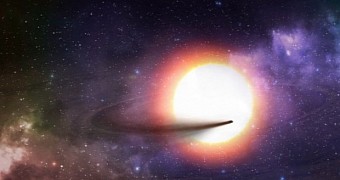Some 1,500 light-years away from Earth, a rocky planet is slowly disintegrating because of the intense heat it is exposed to. Thus, astronomers say that this celestial body is so hot that rocks are literally being vaporized on its surface.
Even cooler, it appears that all the debris and dust the planet is shedding have formed a tail similar to that of comets. This rather impressive tail is forever accompanying the celestial body as it moves in its orbit, circling its parent star.
Just how hot is this distant planet?
In a paper in The Astrophysical Journal, scientists detail that, having studied this planet using the William Herschel Telescope in the Canary Islands, they found that its surface is heated to about 1,800 degrees Celsius (nearly 3,300 degrees Fahrenheit).
The reason this rocky world is this hot is that it sits freakishly close to its parent star. In fact, its orbit is so small that the researchers who have had the chance to study it estimate than an entire year on this celestial body lasts less than a day here on Earth.
“A single year on KIC 1255b lasts only 16 hours on Earth and the whole planet seems to be slowly boiling away under intense heat of its sun,” astronomer and study lead author Jakub Bochinski with the Open University in the UK said in a statement.
Size-wise, KIC 1255b is not all that impressive. On the contrary, it looks like this planet is about as big as our cosmic neighbor Mercury, whose radius is one of about 2,500 kilometers (approximately 1,500 miles). In fact, it is so small that it is very difficult to spot.
However, astronomers say that, when flying around its parent star, it blocks about 1% of its light each and every orbit, just as much as mammoth Jupiter would if it were in its place. This is because the tail of dust and debris following this planet is surprisingly huge.
Studying this planet to better understand Earth
Open University researcher Jakub Bochinski and his colleagues explain that, in the months to come, they hope to use the William Herschel Telescope to peer into the anatomy of this celestial body.
More precisely, the astronomers say that they plan to have a closer look at the dust and the debris comprising its comet-like tail. Whatever data their obtain should help them gain a better understanding of what KIC 1255b is made of.
“By doing that we can find out how typical our Solar System is, helping us learn more about how Earth and other planets were formed,” astronomer Jakub Bochinski commented on the importance of this planned research project.

 14 DAY TRIAL //
14 DAY TRIAL //